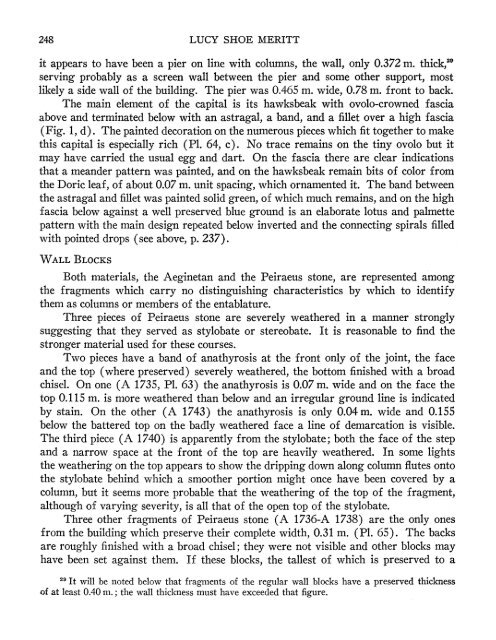the stoa poikile - The American School of Classical Studies at Athens
the stoa poikile - The American School of Classical Studies at Athens
the stoa poikile - The American School of Classical Studies at Athens
You also want an ePaper? Increase the reach of your titles
YUMPU automatically turns print PDFs into web optimized ePapers that Google loves.
248 LUCY SHOE MERITT<br />
it appears to have been a pier on line with columns, <strong>the</strong> wall, only 0.372 m. thick,29<br />
serving probably as a screen wall between <strong>the</strong> pier and some o<strong>the</strong>r support, most<br />
likely a side wall <strong>of</strong> <strong>the</strong> building. <strong>The</strong> pier was 0.465 m. wide, 0.78 m. front to back.<br />
<strong>The</strong> main element <strong>of</strong> <strong>the</strong> capital is its hawksbeak with ovolo-crowned fascia<br />
above and termin<strong>at</strong>ed below with an astragal, a band, and a fillet over a high fascia<br />
(Fig. 1, d). <strong>The</strong> painted decor<strong>at</strong>ion on <strong>the</strong> numerous pieces which fit toge<strong>the</strong>r to make<br />
this capital is especially rich (P1. 64, c). No trace remains on <strong>the</strong> tiny ovolo but it<br />
may have carried <strong>the</strong> usual egg and dart. On <strong>the</strong> fascia <strong>the</strong>re are clear indic<strong>at</strong>ions<br />
th<strong>at</strong> a meander p<strong>at</strong>tern was painted, and on <strong>the</strong> hawksbeak remain bits <strong>of</strong> color from<br />
<strong>the</strong> Doric leaf, <strong>of</strong> about 0.07 m. unit spacing, which ornamented it. <strong>The</strong> band between<br />
<strong>the</strong> astragal and fillet was painted solid green, <strong>of</strong> which much remains, and on <strong>the</strong> high<br />
fascia below against a well preserved blue ground is an elabor<strong>at</strong>e lotus and palmette<br />
p<strong>at</strong>tern with <strong>the</strong> main design repe<strong>at</strong>ed below inverted and <strong>the</strong> connecting spirals filled<br />
with pointed drops (see above, p. 237).<br />
WALL BLOCKS<br />
Both m<strong>at</strong>erials, <strong>the</strong> Aeginetan and <strong>the</strong> Peiraeus stone, are represented among<br />
<strong>the</strong> fragments which carry no distinguishing characteristics by which to identify<br />
<strong>the</strong>m as columns or members <strong>of</strong> <strong>the</strong> entabl<strong>at</strong>ure.<br />
Three pieces <strong>of</strong> Peiraeus stone are severely wea<strong>the</strong>red in a manner strongly<br />
suggesting th<strong>at</strong> <strong>the</strong>y served as stylob<strong>at</strong>e or stereob<strong>at</strong>e. It is reasonable to find <strong>the</strong><br />
stronger m<strong>at</strong>erial used for <strong>the</strong>se courses.<br />
Two pieces have a band <strong>of</strong> an<strong>at</strong>hyrosis <strong>at</strong> <strong>the</strong> front only <strong>of</strong> <strong>the</strong> joint, <strong>the</strong> face<br />
and <strong>the</strong> top (where preserved) severely wea<strong>the</strong>red, <strong>the</strong> bottom finished with a broad<br />
chisel. On one (A 1735, P1. 63) <strong>the</strong> an<strong>at</strong>hyrosis is 0.07 m. wide and on <strong>the</strong> face <strong>the</strong><br />
top 0.115 m. is more wea<strong>the</strong>red than below and an irregular ground line is indic<strong>at</strong>ed<br />
by stain. On <strong>the</strong> o<strong>the</strong>r (A 1743) <strong>the</strong> an<strong>at</strong>hyrosis is only 0.04 m. wide and 0.155<br />
below <strong>the</strong> b<strong>at</strong>tered top on <strong>the</strong> badly wea<strong>the</strong>red face a line <strong>of</strong> demarc<strong>at</strong>ion is visible.<br />
<strong>The</strong> third piece (A 1740) is apparently from <strong>the</strong> stylob<strong>at</strong>e; both <strong>the</strong> face <strong>of</strong> <strong>the</strong> step<br />
and a narrow space <strong>at</strong> <strong>the</strong> front <strong>of</strong> <strong>the</strong> top are heavily wea<strong>the</strong>red. In some lights<br />
<strong>the</strong> wea<strong>the</strong>ring on <strong>the</strong> top appears to show <strong>the</strong> dripping down along column flutes onto<br />
<strong>the</strong> stylob<strong>at</strong>e behind which a smoo<strong>the</strong>r portion might once have been covered by a<br />
column, but it seems more probable th<strong>at</strong> <strong>the</strong> wea<strong>the</strong>ring <strong>of</strong> <strong>the</strong> top <strong>of</strong> <strong>the</strong> fragment,<br />
although <strong>of</strong> varying severity, is all th<strong>at</strong> <strong>of</strong> <strong>the</strong> open top <strong>of</strong> <strong>the</strong> stylob<strong>at</strong>e.<br />
Three o<strong>the</strong>r fragments <strong>of</strong> Peiraeus stone (A 1736-A 1738) are <strong>the</strong> only ones<br />
from <strong>the</strong> building which preserve <strong>the</strong>ir complete width, 0.31 m. (P1. 65). <strong>The</strong> backs<br />
are roughly finished with a broad chisel; <strong>the</strong>y were not visible and o<strong>the</strong>r blocks may<br />
have been set against <strong>the</strong>m. If <strong>the</strong>se blocks, <strong>the</strong> tallest <strong>of</strong> which is preserved to a<br />
29 It will be noted below th<strong>at</strong> fragments <strong>of</strong> <strong>the</strong> regular wall blocks have a preserved thickness<br />
<strong>of</strong> <strong>at</strong> least 0.40 m.; <strong>the</strong> wall thickness must have exceeded th<strong>at</strong> figure.

















